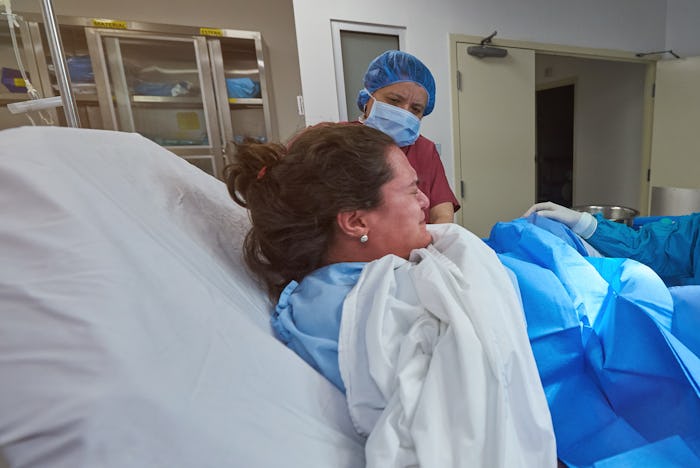Life

Every Woman Goes Through These 4 Stages Of Labor & Birth, Experts Say
As the end of pregnancy nears, moms-to-be are usually full of excitement and nerves about what's next, especially if it's their first baby. There are four defined stages of labor and birth that pregnant women can expect to go through, assuming they don't have a scheduled C-section. While the duration of each stage can vary among women, there is no differentiation from one woman to another in the overall process.
Even though the labor and birthing process is well-established, it's still not always easy to discern whether or not the body is actually in labor. Dr. Melissa Peskin, OB/GYN at Montefiore Health System, tells Romper that the most common thing to confuse moms-to-be are Braxton Hicks contractions. While many women don't feel them at all, Dr. Peskin says that these contractions can be uncomfortable and repetitive, but even if they are "bothersome enough to bring a patient into the evaluation unit, [and] the patient does not make any cervical change, then she is considered to be in false labor."
Another confusion women often experience is determining whether or not their water broke. Doula and childbirth educator Deena Blumenfield tells Romper that women often mistake "vaginal discharge or urine leakage [for] amniotic fluid (water breaking)." Actual amniotic fluid leakage is definitely cause for evaluation, but Blumenfield says women can skip an unnecessary evaluation by smelling the fluid, because amniotic fluid is odorless.
Once a patient is sure she's not experiencing a false alarm, things are pretty straightforward, biologically speaking. The labor and birth process is split up into four stages, with a few sub-phases. Every woman's body is prepared to naturally go through these stages, it's just a matter of how long her body takes to get from one stage to the next.
1Latent & Active Labor
This is the stage that basically every woman associates with the idea of labor. It's the process where the cervix dilates from zero to ten centimeters. Dr. Peskin says this stage is broken into two phases: latent labor and active labor.
Blumenfield says early (latent) labor is when a woman's cervix is dilated, but hasn't reached six centimeters yet. Depending on how many babies a woman has had, Dr. Peskin says this phase can last 14 to 20 hours. During this time, a woman will experience "contractions every two to five minutes... maintaining regularity for about two to three hours and resulting in such painful contractions and force that they actually make it hard for her to speak during the contraction."
Once her cervix has dilated six centimeters, a woman is considered to be in active labor. How long this phase lasts depends on "the functionality of the uterus, the pelvis or passageway, or the size of the baby," says Dr. Peskin, but it's commonly somewhere between two and eight hours.
2Fully Dilated & Pushing
Once the cervix is fully dilated to 10 centimeters, the second stage of labor and birth (which Blumenfield calls "pushing") begins. At this point, the baby is descended and ready to come out. The woman must push to help the baby make its way out.
Dr. Peskin says this stage can last anywhere from less than ten minutes to five hours. However, she notes that it's best if the patient "begins pushing within the first 30 minutes after becoming fully dilated, as this improves her chances of a successful vaginal delivery and reduces complications".
3Placenta & Afterbirth
After the baby has been pushed out and the umbilical cord has been cut, the body typically takes over to expel the placenta and afterbirth. Dr. Peskin says the placenta usually delivers itself (without help from the patient) unless there is a complication. She also says this stage typically lasts less than 30 minutes.
4Recovery
Even though the really hard part is over, a woman is still in a stage of labor and birth immediately following her baby's delivery. For most women, this stage is uneventful in terms of the body. Dr. Peskin notes that during this time "the mother rests, bonds with her newborn, and can even try to nurse." While mom is doing all of those things, Dr. Peskin says she will be "closely monitored by her labor and delivery provider during this period, to ensure she does not have any further bleeding and continues to be stable following the birth of her baby."
The biological process of labor and birth is the same for every woman, however, both Blumenfield and Dr. Peskin agree that the experience itself can vary dramatically for each individual depending on a variety of factors like pain level, duration, and communication. To increase the chance of a positive experience, Blumenfield recommends women and their partners take an in-person child-birthing class. Not only will the class help patients learn the signs of labor as well as the process, but she says it will also help her partner learn how to support her through it all.
The best thing a woman can do prior to labor is educate herself on the process, ask her healthcare provider questions, and gain an understanding of what is in her control and what isn't. That knowledge will help her to stay confident and positive throughout the painful parts of labor and birth until she finally gets to meet the baby that she worked so hard to bring into the world.
Experts:
Deena Blumenfield, ERYT, RPYT, LCCE, FACCE, Owner, Principle Educator, and Doula Madame of Shining Light Prenatal Education
Melissa Peskin, M.D., Assistant Professor, Obstetrics & Gynecology and Women’s Health at Montefiore Health System and Albert Einstein College of Medicine